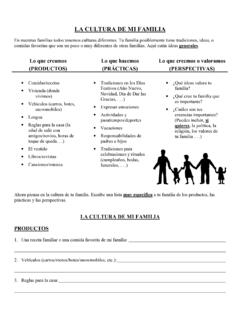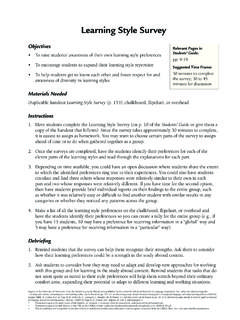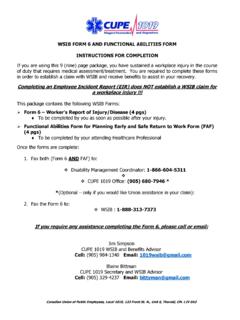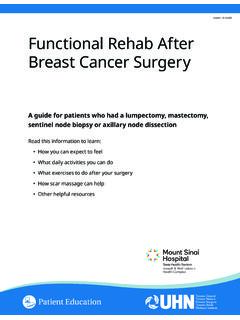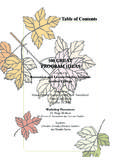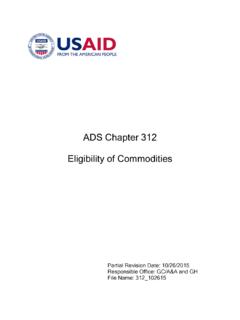Transcription of Learning Style Survey - CARLA
1 Learning Style Survey Objectives Relevant Pages in Students' Guide: To raise students' awareness of their own Learning Style preferences pp. 9-19. To encourage students to expand their Learning Style repertoire Suggested Time Frame: To help students get to know each other and foster respect for and 30 minutes to complete awareness of diversity in Learning styles the Survey ; 30 to 45. minutes for discussion Materials Needed Duplicable handout Learning Style Survey (p. 153); chalkboard, flipchart, or overhead Instructions 1. Have students complete the Learning Style Survey (on p. 10 of the Students' Guide or give them a copy of the handout that follows). Since the Survey takes approximately 30 minutes to complete, it is easiest to assign as homework. You may want to choose certain parts of the Survey to assign ahead of time or to do when gathered together as a group. 2.
2 Once the surveys are completed, have the students identify their preferences for each of the eleven parts of the Learning styles and read through the explanations for each part. 3. Depending on time available, you could have an open discussion where students share the extent to which the identified preferences ring true to their experiences. You could also have students circulate and find three others whose responses were relatively similar to their own in each part and two whose responses were relatively different. If you have time for the second option, then have students provide brief individual reports on their findings to the entire group, such as whether it was relatively easy or difficult to find another student with similar results in any categories or whether they noticed any patterns across the group. 4. Make a list of all the Learning Style preferences on the chalkboard, flipchart, or overhead and have the students identify their preferences so you can create a tally for the entire group ( , if you have 15 students, 10 may have a preference for receiving information in a global way and 5 may have a preference for receiving information in a particular way).
3 Debriefing 1. Remind students that the Survey can help them recognize their strengths. Ask them to consider how their Learning preferences could be a strength in the study abroad context. 2. Ask students to consider how they may need to adapt and develop new approaches for working with this group and for Learning in the study abroad context. Remind students that tasks that do not seem quite as suited to their Style preferences will help them stretch beyond their ordinary comfort zone, expanding their potential to adapt to different Learning and working situations. Regents of the University of Minnesota. From the Maximizing Study Abroad series published by the Center for Advanced Research on Language Acquisition. See: Learning Style Survey : Assessing your own Learning styles can be found on pp. 151 161 in Maximizing study abroad: An instructional guide to strategies for language and culture Learning and use (2009) by Kappler Mikk, B.
4 , Cohen, & Paige, (with Chi, J., Lassegard, J., Maegher, M. & Weaver, S.), and the Survey can be found on pp. 10 19 in Maximizing study abroad: A students' guide to strategies for language and culture Learning and use (2nd ed.) (2006) by Paige , Cohen, , Kappler, B., Chi, J. and Lassegard, J. Permission is granted to make copies of this handout for research or classroom when documented at: Permission is granted to link directly to this URL on the CARLA website: This material may not be reposted on another website or included in another print publication without express permission from the CARLA office. See: 3. Encourage students to challenge themselves. You can increase the number of styles students use by encouraging them to do a bit of Style stretching. For example, in a language Learning context, if you have assigned a reading text in the target language, students who are more intuitive in Style orientation may have no problem inferring meaning from an ambiguous text or a portion of text with difficult vocabulary or language structure.
5 The strategies these students could use are numerous: They could use their knowledge of the world or information from another section of the text that is intelligible and make a logical connection between the two. They could also make use of headings and subheadings, connectors, and other functional guidelines in the text. Students who prefer concrete-sequential Learning have a more difficult time inferring meaning from an ambiguous or difficult text because they are typically more comfortable going from one word to the next and one sentence to the next. This may be an excellent instance for the classroom teacher to discuss Style stretching with the students, that is, the advantages of shifting or expanding their Style a bit to accommodate a daunting language task and selecting strategies to support that Style shift. Tips This is a useful ice-breaker activity to do early on in a language course or study abroad program.
6 One teacher scheduled 10-minute mid-semester feedback sessions with all of her students. The sessions provided a good opportunity to touch base informally with students about their strengths and needs and follow up on their Survey answers. This is also a good way to discuss the information if students are not comfortable sharing with the entire class. Adaptations and Extensions The Survey could be translated into the target language for more advanced language students. Even if the surveys are done in English, the face-to-face part of the activity can be done in the target language to maximize language Learning . This is true even for beginning or intermediate language learners since you can provide model questions for lower-level students, while more advanced students may not need them. Regents of the University of Minnesota. From the Maximizing Study Abroad series published by the Center for Advanced Research on Language Acquisition.
7 See: Learning Style Survey : Assessing your own Learning styles can be found on pp. 151 161 in Maximizing study abroad: An instructional guide to strategies for language and culture Learning and use (2009) by Kappler Mikk, B., Cohen, & Paige, (with Chi, J., Lassegard, J., Maegher, M. & Weaver, S.), and the Survey can be found on pp. 10 19 in Maximizing study abroad: A students' guide to strategies for language and culture Learning and use (2nd ed.) (2006) by Paige , Cohen, , Kappler, B., Chi, J. and Lassegard, J. Permission is granted to make copies of this handout for research or classroom when documented at: Permission is granted to link directly to this URL on the CARLA website: This material may not be reposted on another website or included in another print publication without express permission from the CARLA office. See: ng Study iz i m Ab Maxi road Learning Style Survey : cti vity A.
8 Assessing Your Own Learning styles Andrew D. Cohen, Rebecca L. Oxford, and Julie C. Chi The Learning Style Survey1 is designed to assess your general approach to Learning . It does not predict your behavior in every instance, but it is a clear indication of your overall Style preferences. For each item, circle the response that represents your approach. Complete all items. There are 11 major activities representing 12 different aspects of your Learning Style . When you read the statements, try to think about what you usually do when Learning . It typically takes about 30 minutes to complete the Survey . Do not spend too much time on any item indicate your immediate feeling and move on to the next item. For each item, circle your response: 0 = Never 1 = Rarely 2 = Sometimes 3 = Often 4 = Always Part 1: HOW I USE MY PHYSICAL SENSES. 1. I remember something better if I write it down.
9 0 1 2 3 4. 2. I take detailed notes during lectures. 0 1 2 3 4. 3. When I listen, I visualize pictures, numbers, or words in my head. 0 1 2 3 4. 4. I prefer to learn with TV or video rather than other media. 0 1 2 3 4. 5. I use color-coding to help me as I learn or work. 0 1 2 3 4. 6. I need written directions for tasks. 0 1 2 3 4. 7. I have to look at people to understand what they say. 0 1 2 3 4. 8. I understand lectures better when professors write on the board. 0 1 2 3 4. 9. Charts, diagrams, and maps help me understand what someone says. 0 1 2 3 4. 10. I remember peoples' faces but not their names. 0 1 2 3 4. A - Total 1. The format of the Learning Style Survey and a number of the dimensions and items are drawn from Oxford; other key dimensions and some of the wording of items comes from Ehrman and Leaver: Oxford, R. L. (1995). Style Analysis Survey . In J. Reid (Ed.)
10 , Learning styles in the ESL/EFL classroom (pp. 208-215). Boston: Heinle &. Heinle/Thomson International. Ehrman, M. E. & Leaver, B. L. (2003). Cognitive styles in the service of language Learning . System 31: 393-415. Regents of the University of Minnesota. From the Maximizing Study Abroad series published by the Center for Advanced Research on Language Acquisition. See: Learning Style Survey : Assessing your own Learning styles can be found on pp. 151 161 in Maximizing study abroad: An instructional guide to strategies for language and culture Learning and use (2009) by Kappler Mikk, B., Cohen, & Paige, (with Chi, J., Lassegard, J., Maegher, M. & Weaver, S.), and the Survey can be found on pp. 10 19 in Maximizing study abroad: A students' guide to strategies for language and culture Learning and use (2nd ed.) (2006) by Paige , Cohen, , Kappler, B., Chi, J. and Lassegard, J.
